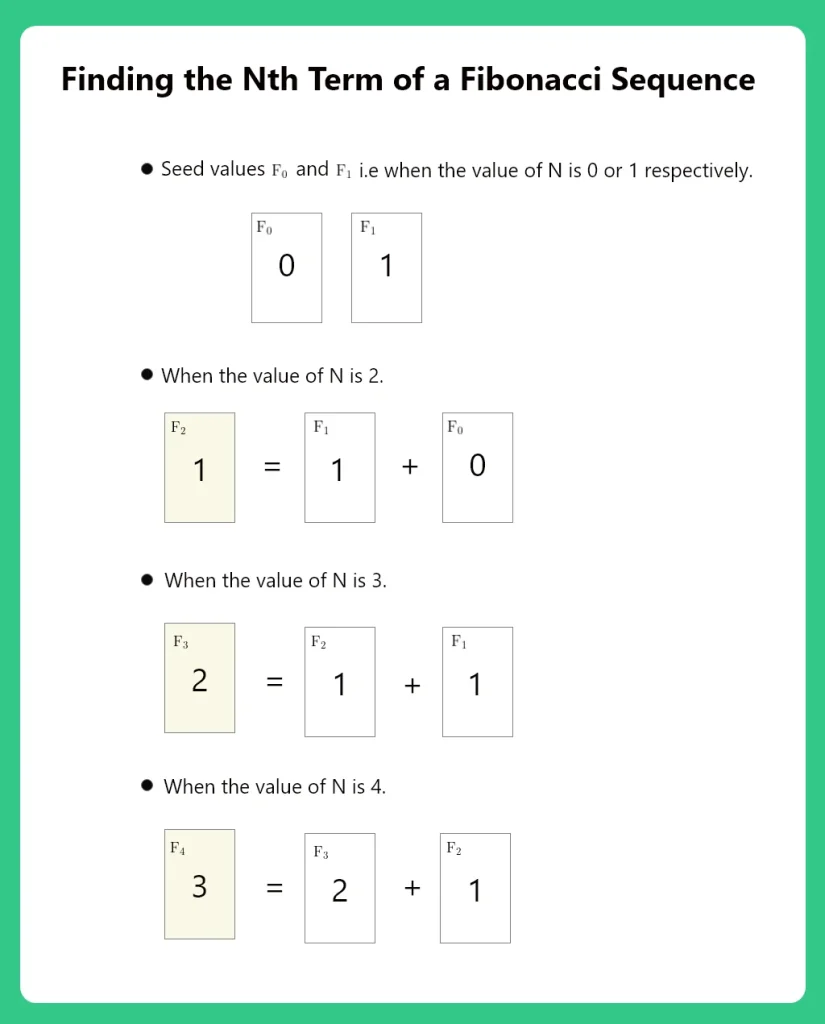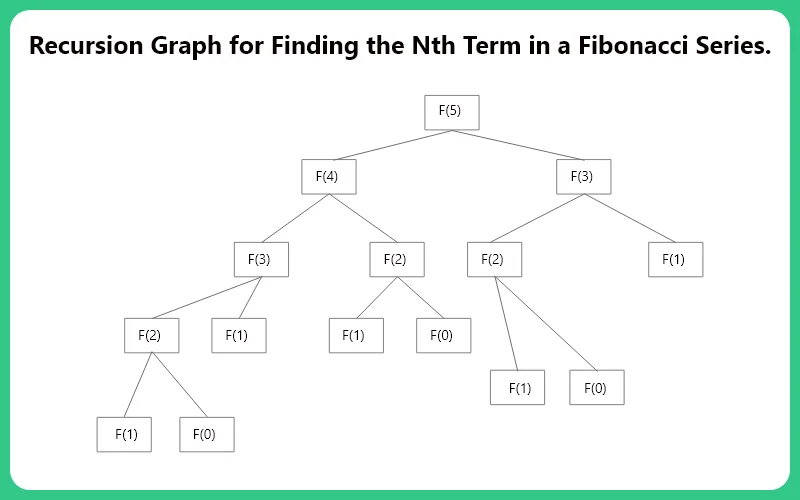Finding the Nth Term of the Fibonacci Series in C++
What is a Fibonacci Series and Find the Nth Term of the Fibonacci Series?
The Fibonacci numbers, commonly denoted F(N) form a sequence, called the Fibonacci series, such that each number is the sum of the two preceding ones, starting from 0 and 1.
That is, F(0) = 0, F(1) = 1 F(n) = F(n - 1) + F(n - 2), for n > 1. Given N, calculate F(N). Example 1: Input:n = 2 Output: 1 Explanation: F(2) = F(1) + F(0) = 1 + 0 = 1

Finding the Nth Term of the Fibonacci Series
In mathematics, the Fibonacci numbers, commonly denoted Fₙ form a sequence, the Fibonacci sequence, in which each number is the sum of the two preceding ones. The sequence commonly starts from 0 and 1, although some authors omit the initial terms and start the sequence from 1 and 1 or from 1 and 2.
The Series has two seed values F0 = 0 and F1 = 1. Starting with the seed values we keep adding and changing the “a” and “b” values which initially are a = F0 and b = F1.
The General formula for the Fibonacci series is
- Fn = Fn-1 + Fn-2
Where Fn is the Output.

C++ Code
Method 1: Using Recursion
//Fibonacci Series using Recursion
#include<bits/stdc++.h>
using namespace std;
int F(int N)
{
if (N <= 1)
{
return N;
}
return F(N-1) + F(N-2);
}
int main ()
{
int N = 5;
cout << F(N);
return 0;
}Output
5
Explanation
The objective is to recursively add the seed values and keep on adding forming a Fibonacci Series until the input index is reached.
The algorithm for the above code is as follows:
- Declare an int function F(int N) that takes the index+1 value as an argument.
- Check if the integer N is lesser or equal to 1. If yes return the integer N.
- In the return statement call the function F(N) recursively. This process is shown in the recursion tree.
- Print the output after calling the F(5) function using cout command.
The output for the above code is the number from the Fibonacci series at the given index N-1.

Method 2: Using Space Optimization
C++ Code
// Fibonacci Series using Space Optimized Method
#include<bits/stdc++.h>
using namespace std;
int F(int N)
{
int a = 0, b = 1, c, i;
if( N == 0)
return a;
for(i = 2; i <= N; i++)
{
c = a + b;
a = b;
b = c;
}
return b;
}
// Driver code
int main()
{
int N = 5;
cout << F(N);
return 0;
}Output
5
Explanation
The objective is to add the seed values and keep on adding forming a Fibonacci Series until the input index is reached. Then Print out the Value at the given index of the Fibonacci series.
The algorithm for the above code is as follows:
- Declare an integer function F(int N) which takes an integer argument N.
- Initialize a and b as seed values and declare an integer variable c for calculation and i for iteration.
- Check if N==0, if True return 0.
- Iterate through using a for loop with the condition i<=N.
- Perform F(N) = F(N-1) + F(N-2).
- Return the value of F(N) i.e “b”.
- Print the Output using cout command and call the function F(5).
The output for the above code is the number from the Fibonacci series at the given index N-1.
- Formula for Finding the Nth Term of the Fibonacci Series.
Armstrong number in a given range
Fibonacci Series upto nth term
Find the Nth Term of the Fibonacci Series
Method 3: Using Matrix Multiplication
C++ Code
// Using Matrix
#include<bits/stdc++.h>
using namespace std;
void multiply(int fibonacci[2][2], int Mat[2][2]);
void power(int fibonacci[2][2], int N);
int F(int N)
{
int fibonacci[2][2] = { { 1, 1 }, { 1, 0 } };
if (N == 0)
return 0;
power(fibonacci, N - 1);
return fibonacci[0][0];
}
void multiply(int fibonacci[2][2], int Mat[2][2])
{
int x = fibonacci[0][0] * Mat[0][0] +
fibonacci[0][1] * Mat[1][0];
int y = fibonacci[0][0] * Mat[0][1] +
fibonacci[0][1] * Mat[1][1];
int z = fibonacci[1][0] * Mat[0][0] +
fibonacci[1][1] * Mat[1][0];
int w = fibonacci[1][0] * Mat[0][1] +
fibonacci[1][1] * Mat[1][1];
fibonacci[0][0] = x;
fibonacci[0][1] = y;
fibonacci[1][0] = z;
fibonacci[1][1] = w;
}
void power(int fibonacci[2][2], int N)
{
int i;
int Mat[2][2] = { { 1, 1 }, { 1, 0 } };
for(i = 2; i <= N; i++)
multiply(fibonacci, Mat);
}
// Driver code
int main()
{
int N = 5;
cout << " " << F(N);
return 0;
}
Output
5
Explanation
The objective is to use matrix multiplication to form a Fibonacci Series using the given Formula and print out the value at the given index of the Fibonacci series.
The algorithm for the above code is as follows:
- Declare an integer function F( int N) which accepts integer values N as argument.
- Create a 2D integer matrix or dimensions 2×2 and initialize it.
- Check if N==0, if True return 0.
- Using Matrix Multiplication raise the matrix fibonacci[2][2] to the power of N.
- Return the First element of the matrix i.e fibonacci[0][0].
- Print the output using cout command and call the function F(5).
The output for the above code is the number from the Fibonacci series at the given index N-1.
- Formula for Finding the Nth Element of a Fibonacci series using Matrix Multiplication.
Prime Course Trailer
Related Banners
Get PrepInsta Prime & get Access to all 200+ courses offered by PrepInsta in One Subscription
- Positive or Negative number: C | C++ | Java | Python
- Even or Odd number: C | C++ | Java | Python
- Sum of First N Natural numbers: C | C++ | Java | Python
- Sum of N natural numbers: C | C++ | Java | Python
- Sum of numbers in a given range: C | C++ | Java | Python
- Greatest of two numbers: C | C++ | Java | Python
- Greatest of the Three numbers: C | C++ | Java | Python
- Leap year or not: C | C++ | Java | Python
- Prime number: C | C++ | Java | Python
- Prime number within a given range: C | C++ | Java | Python
- Sum of digits of a number: C | C++ | Java | Python
- Reverse of a number : C | C++ | Java | Python
- Palindrome number: C | C++ | Java | Python
- Armstrong number : C | C++ | Java | Python
- Armstrong number in a given range : C | C++ | Java | Python
- Fibonacci Series upto nth term : C | C++ | Java | Python
- Find the Nth Term of the Fibonacci Series : C | C++ | Java | Python
- Factorial of a number : C | C++ | Java | Python
- Power of a number : C | C++ | Java | Python
- Factor of a number : C | C++ | Java | Python
- Strong number : C | C++ | Java | Python
- Perfect number : C | C++ | Java | Python
- Automorphic number : C | C++ | Java | Python
- Harshad number : C | C++ | Java | Python
- Abundant number : C| C++ | Java | Python
- Friendly pair : C | C++ | Java | Python


30+ Companies are Hiring
Get Hiring Updates right in your inbox from PrepInsta


method 2 is wrong
right is :
int Nth_fibonaci(int num)
{ if(num == 1 || num == 2)
{
return 1;
}
else{
int a = 1;
int b = 1;
int c = 0;
for(int i = 3;i<=num + 1;i++)
{
c = a + b ;
a = b;
b = c ;
}
return c;
}